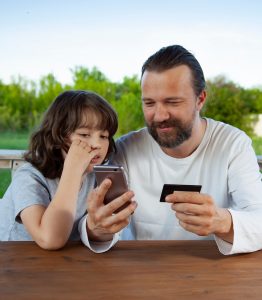Experiential Retail: Unifying Online And Offline Worlds In The Retail Industry

Among all the changes that retailers had to adapt to over the past decade, one of the most important – and one that some, unfortunately, didn’t recognize – is the transition to experiential retail. You are no longer selling things. You’re selling experiences. Coinciding with the rise of the millennial generation and its spending power, 76% of consumers, according to Momentum Worldwide, are interested in spending their money on experiences instead of material items.
There’s a great example in Harvard Business Review of the natural progression that leads to economic change. In an agrarian economy, moms made birthday cakes from scratch for their kids. Then, when the economy progressed to become goods-based, moms bought cake mixes to make birthday cakes. Later, when the economy evolved to focus on services, they bought cakes at a bakery. Now, moms schedule birthday parties at entertainment or sports venues, which provide a cake as a part of the total experience.
To use the above example, if you sell cake mixes, how can you adapt your store to compete with a business that throws the whole birthday party?
For retailers who sell apparel, electronics, jewelry, home goods, or other merchandise, unpacking what experiential retail means for your business can be quite complicated. For an example a little closer to home, if you’ve always sold merchandise at a brick-and-mortar store, how do you compete with e-commerce retailers that enable shoppers to find the items they need by browsing on a smartphone, tablet, or PC and then order with a just a click?
Or, if you operate an e-commerce business, how do you compete with physical stores that allow shoppers to touch, feel, try on, demo — experience — the items they’re interested in buying?
The marriage of online and offline retail
An effective strategy for building customer engagement and enhancing customer experiences is to give shoppers both “online” and “offline” retail experiences, regardless of how they choose to shop. For example, these technologies can help you build experiences that give your customers the best of both worlds:
- Virtual shopping assistants: In a physical store, there’s usually someone a customer can turn to for answers. Virtual shopping assistants provide that same experience to online shoppers, so they don’t need to track down a phone number and wait on hold for the information they need. Artificial intelligence-powered virtual shopping assistants can make recommendations, suggest complementary products, and answer basic questions on topics such as shipping, returns, and local store locations.
- Push notifications: Online, shoppers often find deals front and center and receive coupon codes just for logging on. Brick-and-mortar retailers can provide similar experiences using Bluetooth beacons or RFID sensors to push offers to their customers’ smartphones. Location solutions can even enable a retailer to send an offer when a shopper is browsing in a particular area of the store or lingering by a display, delivering an incentive at the moment of decision.
- Virtual fitting rooms: Augmented reality (AR) technology can give shoppers the ability to “try on” clothes virtually. The same technology can also show a shopper how furniture or home décor would work in a room in their house.
- Cashierless checkout: E-commerce shoppers enjoy the speed and convenience of one-click ordering. With the right technology, physical retail can be just as easy. Systems like the one developed for Amazon Go stores use cameras, sensors, AI, and other technologies to enable customers to select the items they want, leave the store, and receive a receipt on their smartphones.
Experiential retail as a traffic driver
It’s crucial to recognize that retailers shouldn’t implement technology for technology’s sake. It should support the customer experiences you envision.
The first step toward delivering loyalty-building customer experiences is defining and understanding your market. Are the majority of your customers young mothers? Middle-aged sportsmen? Empty nesters? Teens? Once you understand who your shoppers are, you can begin to blend products, services, personalization, engagement, and convenience into experiences that delight them and inspire them to keep your brand top of mind.
Also, remember that experiential retail isn’t limited to high-tech capabilities. Offering coffee to a man waiting in a “husband chair” outside a fitting room, creating a party atmosphere for a bridal party shopping for their ensembles, setting up gaming systems for demos, or building online or social media communities can substantially contribute to customer engagement and make happy memories for shoppers.
Experiential retail can make your store or website a destination where customers linger after they’ve made their purchases. They’ll be more likely to share posts and photos of their shopping experiences on social media. You may even see a greater percentage of first-time shoppers turning into loyal customers.
Experiential retail, done right, will bring shoppers to your store, increase engagement, and build their loyalty.
To learn how SAP and Beyond Technologies can help your Retail business, contact us:
https://www.beyondtechnologies.com/contact
Article published in Digitalist Magazine: Experiential Retail: Unifying Online And Offline Worlds In The Retail Industry
About Kurt Ramcharan
 Kurt Ramcharan is the Marketing and Communication Director of Beyond Technologies. As an experienced marketing executive, he is passionate about developing go-to-market and demand generation strategies that blend traditional techniques with emerging technologies. Kurt has over 15 years of experience with B2B tech companies and a deep understanding of the shifting business dynamics within the wholesale, distribution and retail segments. Such expertise enables him to work leading retailers and wholesalers across North America. This experience allowed him to develop a strong knowledge of the supply chain, customer experience, omnichannel operations, and pricing and promotion business processes. With a people-first mindset, Kurt’s approach is about combining human behavior knowledge with the latest technologies to create meaningful digital transformations and engaging customer experiences.
Kurt Ramcharan is the Marketing and Communication Director of Beyond Technologies. As an experienced marketing executive, he is passionate about developing go-to-market and demand generation strategies that blend traditional techniques with emerging technologies. Kurt has over 15 years of experience with B2B tech companies and a deep understanding of the shifting business dynamics within the wholesale, distribution and retail segments. Such expertise enables him to work leading retailers and wholesalers across North America. This experience allowed him to develop a strong knowledge of the supply chain, customer experience, omnichannel operations, and pricing and promotion business processes. With a people-first mindset, Kurt’s approach is about combining human behavior knowledge with the latest technologies to create meaningful digital transformations and engaging customer experiences.
Contact
Canada
111 Robert-Bourassa Blvd, Suite 4500
Montréal (Québec) H3C 2M1
____________________________
185 The West Mall, Suite 1010
Etobicoke (Ontario) M9C 1B8
United States
111 Town Square Pl., Suite 1203
Jersey City, New Jersey, 07310
France
93, avenue Charles de Gaulle
92200 Neuilly-sur-Seine
South Africa
Ballywood Office Park,
33 Ballyclare Dr,
Bryanston,
Johannesburg, 2191
____________________
1st Floor
27 Somerset Road
Green Point
Cape Town 8005
Morocco
Casanearshore
Shore 2B - 6th floor
1100 El Qods Blvd (Sidi Maârouf)
20520, Casablanca
Telephone: 514 227-7323
Fax: 1 888 679 0002
Toll Free: 1 877 449-7323
Contact



